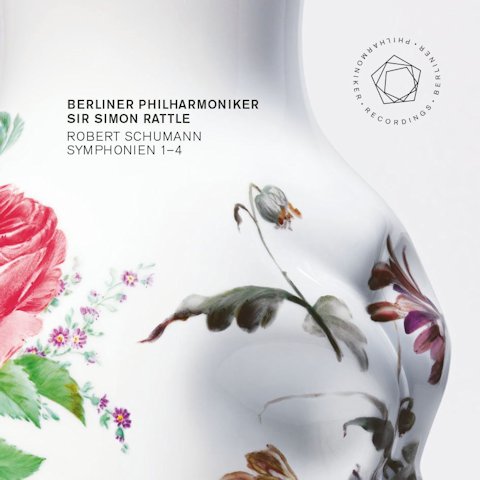SCHUMANN Symphonies 1 - 4
View record and artist detailsRecord and Artist Details
Composer or Director: Robert Schumann
Genre:
Orchestral
Label: Berlin Philharmoniker
Magazine Review Date: 07/2014
Media Format: Digital Versatile Disc
Media Runtime: 300
Mastering:
DDD
Catalogue Number: BPHR140011

Tracks:
| Composition | Artist Credit |
|---|---|
| Symphony No. 1, 'Spring' |
Robert Schumann, Composer
Berlin Philharmonic Orchestra Robert Schumann, Composer Simon Rattle, Conductor |
| Symphony No. 2 |
Robert Schumann, Composer
Berlin Philharmonic Orchestra Robert Schumann, Composer Simon Rattle, Conductor |
| Symphony No. 3, 'Rhenish' |
Robert Schumann, Composer
Berlin Philharmonic Orchestra Robert Schumann, Composer Simon Rattle, Conductor |
| Symphony No. 4 |
Robert Schumann, Composer
Berlin Philharmonic Orchestra Robert Schumann, Composer Simon Rattle, Conductor |
Author: David Threasher
That all seems to be changing gradually, although far too gradually, and too late of course for poor Schumann himself. In the vanguard of those who would pooh-pooh lazy notions of a flawed composer unversed in orchestration are the directors of smaller orchestras playing either period or modern instruments, homing in on the structural ingenuity and tensile strength of these four works, adopting fleeter tempi than hitherto and exploiting the athletic opportunities offered by today’s crop of virtuoso chamber orchestras. The result might have been christened ‘Schumann-lite’ in recent issues of Gramophone but that’s ‘lite’ as in texture, not ‘light’ as in cosmetic and unadventurous.
Unadventurous is not a charge anyone could ever level at Rattle. Always with a keen ear (not to mention baton) cocked towards the period-practice movement even as he has fronted two of the great symphonic behemoths of our time, it has been his gift to persuade those Romantic institutions to follow him on his explorations not only into repertoires outside those frequented by his predecessors but also into styles and techniques that can open new vistas on the music that forms the core of their being.
Thus Rattle makes no apology for Schumann’s orchestration, finding the myriad colours with which the composer imbued his music. Neither is there a hint of routine in the playing: the richness of the Berlin strings and beauty of the woodwind go without saying. There’s the expected virtuosity, too, in places such as the Scherzo of the Second. This, though, one cannot help but feel, is the muscularity of a thoroughbred rather than the litheness of a dancer: compare the Chamber Orchestra of Europe in Paris with Nézet-Séguin, who whirl through this music seemingly without a care (and without Rattle’s contrived holdings-back in the second Trio).
That’s an underlying theme here. Rattle’s tempi are broader in all the symphonies except the Rhenish, where he finds a sinewy robustness and even a grandeur that are not in Nézet-Séguin’s conception. The other aspect less apparent in these performances is spontaneity: whereas the COE readings spring virtually fully formed to life, with their subtle gradations of tempo growing organically from the thrust of the music, the Berlin traversals are perhaps somewhat more studied. There’s nothing poco a poco about the accelerando towards the end of the Spring Symphony, for example, or particularly natural about the ritards as the Scherzo of the D minor Symphony melts into the finale or as fig V in the finale is approached (about a minute in).
That D minor Symphony is the original (1841) version of what became the Fourth a decade later, an increasingly popular choice (and Brahms’s preference). However, the first movement never seems to settle into its pulse and proves an oddly unsatisfactory experience. What is more than satisfactory throughout, though, is the sound of the recording – preserving the warmth and sustain of the BPO as the music bounces off the walls of the Philharmonie. Timpani are an especially notable presence throughout, clouding the opening of the Spring, for example, although perhaps the faders might have been pushed up a notch for the violin solos in the D minor (as they sound as if they have been for the brass fanfares near the end of the Rhenish).
Talking of satisfaction, the set comes in a linen-bound book, generously annotated in two languages and decorated with pictures of specially commissioned vases. A Blu-ray disc preserves the live performances in vision (and five-channel surround sound), and there is not only a download code to access high-resolution masters of the recordings but also a seven-day ticket for the BPO’s much-acclaimed Digital Concert Hall. The package as a whole launches the orchestra’s in-house label in sumptuous style and deserves to do well – admirers of the Philharmonic and/or Rattle will need no persuading. For me, though, the COE with Nézet-Séguin just edges the BPO and Rattle for a digital Schumann cycle – albeit with the revised Fourth – with its infectious impulsiveness and joie de vivre.
Discover the world's largest classical music catalogue with Presto Music.

Gramophone Digital Club
- Digital Edition
- Digital Archive
- Reviews Database
- Full website access
From £8.75 / month
Subscribe
Gramophone Full Club
- Print Edition
- Digital Edition
- Digital Archive
- Reviews Database
- Full website access
From £11.00 / month
Subscribe
If you are a library, university or other organisation that would be interested in an institutional subscription to Gramophone please click here for further information.




